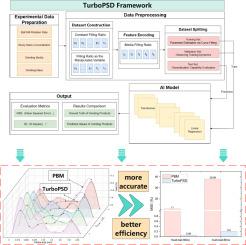TurboPSD prediction framework: Utilizing multivariable temporal dynamics for precise grinding production PSD (particle size distribution) estimates
IF 4.6
2区 工程技术
Q2 ENGINEERING, CHEMICAL
引用次数: 0
Abstract
Population Balance Model (PBM), most commonly used model for grinding dynamics, has been characterized by large errors in the prediction of multiple independent variables. To address these limitations, we propose a novel framework, TurboPSD, which leverages artificial intelligence models to overcome the lack of flexibility and improve forecasting performance. For the single-fill case, the framework is capable of learning the temporal dynamics between grit size and productivity, achieving a minimum mean squared error of just 0.06%, significantly outperforming the PBM approach, which exhibits an MSE of 11.86%. Furthermore, we extend the framework to multi-fill scenarios by incorporating fill amount as an additional feature. Compared to the PBM’s MSE of 38.08%, the framework demonstrates a substantial improvement, reducing the MSE to 0.26%. Experimental results confirm that TurboPSD Prediction Framework surpasses PBM approaches in terms of accuracy, robustness, and efficiency, demonstrating strong potential for widespread application in mineral processing industry.

TurboPSD预测框架:利用多变量时间动态精确研磨生产PSD(粒度分布)估计
人口平衡模型(PBM)是最常用的磨矿动力学模型,其特点是在多自变量预测时误差较大。为了解决这些限制,我们提出了一个新的框架,TurboPSD,它利用人工智能模型来克服灵活性的缺乏并提高预测性能。对于单次充填的情况,该框架能够学习粒度和产能之间的时间动态,实现最小均方误差仅为0.06%,显著优于PBM方法,其MSE为11.86%。此外,我们通过将填充量作为附加功能将框架扩展到多填充场景。与PBM的38.08%的MSE相比,该框架的MSE有了很大的改善,将MSE降至0.26%。实验结果证实,TurboPSD预测框架在准确性、鲁棒性和效率方面均优于PBM方法,在矿物加工行业具有广泛应用的潜力。
本文章由计算机程序翻译,如有差异,请以英文原文为准。
求助全文
约1分钟内获得全文
求助全文
来源期刊

Powder Technology
工程技术-工程:化工
CiteScore
9.90
自引率
15.40%
发文量
1047
审稿时长
46 days
期刊介绍:
Powder Technology is an International Journal on the Science and Technology of Wet and Dry Particulate Systems. Powder Technology publishes papers on all aspects of the formation of particles and their characterisation and on the study of systems containing particulate solids. No limitation is imposed on the size of the particles, which may range from nanometre scale, as in pigments or aerosols, to that of mined or quarried materials. The following list of topics is not intended to be comprehensive, but rather to indicate typical subjects which fall within the scope of the journal's interests:
Formation and synthesis of particles by precipitation and other methods.
Modification of particles by agglomeration, coating, comminution and attrition.
Characterisation of the size, shape, surface area, pore structure and strength of particles and agglomerates (including the origins and effects of inter particle forces).
Packing, failure, flow and permeability of assemblies of particles.
Particle-particle interactions and suspension rheology.
Handling and processing operations such as slurry flow, fluidization, pneumatic conveying.
Interactions between particles and their environment, including delivery of particulate products to the body.
Applications of particle technology in production of pharmaceuticals, chemicals, foods, pigments, structural, and functional materials and in environmental and energy related matters.
For materials-oriented contributions we are looking for articles revealing the effect of particle/powder characteristics (size, morphology and composition, in that order) on material performance or functionality and, ideally, comparison to any industrial standard.
 求助内容:
求助内容: 应助结果提醒方式:
应助结果提醒方式:


